Regional economy. Рубрика в журнале - Economic and Social Changes: Facts, Trends, Forecast
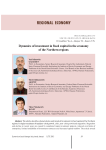
Dynamics of investment in fixed capital in the economy of the northern regions
Статья научная
The article describes characteristics and trends of investment in fixed capital of the Northern regions. It singles out phases of rapid pre-crisis growth, crisis, post-crisis growth and stagnation. Stagnation and decline in recent years are caused by completed major investment projects, reduced own funds of enterprises, limited availability of investment resources and increased capital outflow. The article reveals that the growth of investment in fixed capital of the North in the post-crisis period is provided by the regions, carrying out major investment in oil and gas pipeline transport, oil extraction, production and distribution of electricity, gas and water. The changes in the sectoral structure of investment in fixed capital of the Northern regions are barely visible; the share of investment in the traded sector is still high, especially in mining, due to the Northern regions’ specialization in the extractive industries. The share of investment in the public sector and social services remains low...
Бесплатно
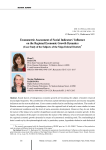
Статья научная
Social factors of endogenous economic growth are becoming the subject of modern research increasingly frequently. The contribution of human capital individual parameters and income inequality indicators are the most studied ones. Cross-country studies lead to conflicting conclusions. The results of Russian research are generally unambiguous, since the regional level of analysis is more similar in terms of institutional conditions and the level of socio-economic development. However, they do not define the nature of the impact of a number of significant social indicators on regional economic growth. In this regard, the purpose of the paper is to determine the nature of the influence of a set of social indicators on the regional economic growth dynamics by means of econometric modeling tools. The methodological basis is made up by the epistemological tools, in particular, system, hypothesis-deductive and dialectical approaches, as well as the methods of content analysis and econometric modeling. The most significant results characterizing the scientific novelty of the presented research include the following: 1) it is determined that the impact of the population's birth rate, mortality and morbidity on GRP corresponds to the nature of the dependencies identified for countries having experienced the second demographic transition; 2) it is established that the character of influence of the indicators of “life expectancy”, and “the number of students studying in bachelor, specialist, master degree programs” and “the number of employees with higher education in the region's economy” on the GRP does not correspond to the trends in developed countries; 3) it is proved that the inconsistency of the obtained results is a consequence of the underestimation of human capital as the main factor in the development of the Russian economy at the present stage; 4) the extent and consequences of the restraining effect of the analyzed social indicators on the dynamics of regional economic growth are determined. Based on the results of econometric modeling, the priorities of regional socio-economic policy for the medium term are identified, depending on the level of their impact. The authors associate the prospects for future research with a deeper study of the impact of life expectancy and mortality factors on the regional economic growth, as well as the verification of this model for the entire set of regions of the Russian Federation.
Бесплатно
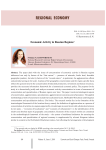
Economic activity in Russian regions
Статья научная
The paper deals with the issues of concentration of economic activity in Russian regions influenced not only by factors of the “first nature” - presence of minerals, fertile land, favorable geographic position, but also by factors of the “second nature”, in particular, the agglomeration effects and potential savings in the scale. Analysis of the geographic concentration and the region-specific focus reflects the general trend in the concentration of industrial production, investment and human resources, provides the necessary information framework for a harmonized economic policy. The purpose for the study is to theoretically justify and analyze economic activity concentration in terms of assessment of concentration and specialization of Russian regions over time. The paper reveals terminological aspects of concentration, agglomeration, specialization, agglomeration economics and urbanization. The applied methodological tools of assessment include the localization factor, Herfindahl-Hirschman and Krugman concentration and specialization indices, Gini index...
Бесплатно
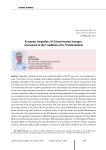
Economic inequality of citizens beyond averages: assessment in the conditions of its transformation
Статья научная
Inequality in Russia has been at a consistently high level for 30 years, but it is not permanent or static. New forms of it are emerging, such as digital inequality, inequality of life and work balance, health inequality, inequality of the coronavirus crisis. The difference between the richest and poorest in food consumption in terms of volume is shrinking, but in terms of quality it is growing. The purpose of the study is to substantiate the need to improve approaches to the measurement of economic inequality of citizens on the basis of determining the features of its modern transformation. The hypothesis of the study is that economic inequality in Russia is transforming, and the existing approaches to its assessment do not allow us to comprehensively and objectively determine its current state, which leads to the ineffectiveness of the measures taken by the government to smooth it out. A comparative analysis of the classical indicators of economic inequality was conducted: the Gini coefficient, the Theil, Atkinson, Palma indices, R/P 10% ratio (the ratio of the average income of the richest 10% to the poorest 10%), R/P 20% ratio (the ratio of the average income of the richest 20% to the poorest 20%), decile differentiation ratio (the ratio of the lowest income in the tenth decile to the highest income in the first decile) and quintile differentiation ratio (the ratio of the lowest income in the fifth quintile to the highest income in the first quintile). The results of the assessment of inequality in Russia obtained by eight organizations (Rosstat, CIS Stat, World Bank, Luxembourg Income Study, Credit Suisse, World Inequality Database, UN Development Program, European Bank for Reconstruction and Development) are compared. In Russia, income inequality remains consistently high, wealth inequality is excessive (Credit Suisse estimates the Gini coefficient at 0.88), and opportunity inequality is less significant in comparison to them. It is proved that the classical statistical indicators do not reflect the transformation of economic inequality, new markers are needed for this. Rosstat estimates income inequality and consumption inequality, leaving out wealth inequality and nonmonetary manifestations of economic inequality. Four directions for improving approaches to the diagnostics of economic inequality in Russia were identified: a qualitative assessment of the manifestations of consumption inequality, nonmonetary manifestations of economic inequality, wealth distribution and the increase in income differentiation within the groups of the wealthiest citizens.
Бесплатно
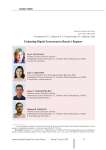
Evaluating digital ecosystems in Russia's regions
Статья научная
Successful establishment and functioning of the digital economy is possible only in an adequate digital ecosystem, but the semantic and structural content of this system has not been defined adequately yet. Such uncertainty can be found at different levels (federal, regional and local) and in various aspects: subject-related, branch, segment, technical and others. At the same time, the need to implement effective measures for the development of regional digital ecosystems requires not only an understanding of their qualitative content, but also an accurate quantitative assessment. Our paper analyzes conceptual approaches to the definition of a digital ecosystem, provides our own understanding of its full content, which allows us to build a sufficiently verifiable assessment of digital ecosystems development at the regional level. We present a technique for assessing the development of regional digital ecosystems; according to this technique two integrated indices are calculated, and on this basis we carry out an analysis on 82 constituent entities of Russia over the period of two years. The study reveals the existence of significant differentiation between the regions according to the level of development of digital ecosystems; it also helps identify a number of characteristic types of regions in this context. Our assessment has shown that, along with the majority of the regions where the development of digital ecosystems is defined as average, some regions show opposite trends. There are regions, for example, the Belgorod and Kirov oblasts, in which the conditions for the digital environment are below average, but the level of ecosystem development in them is average or higher. There are regions where the situation is the opposite, i.e. the conditions are quite high, but the level of development of the digital ecosystem as a whole leaves much to be desired. Such a negative example is the Moscow Oblast. We also identify leading regions and problem regions. We hope that a reliable assessment of development of digital ecosystems using our technique will help work out effective solutions for successful promotion of the digital economy in Russia.
Бесплатно
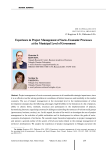
Experience in project management of socio-economic processes at the municipal level of government
Статья научная
Project management of socio-economic processes is of considerable strategic importance, since it is an effective tool for solving problems in conditions of limited resources and instability in the market economy. The use of project management at the municipal level in the implementation of urban development strategies has the following advantages: high flexibility in the formation of a list of projects; ability to choose forms, methods, resources and participants in the implementation of projects; harmonizing interests, organizing constructive dialogue and pooling the resources of various social groups (government, business, society), etc. In this regard, the aim of the work is to investigate the use of project management in the activities of public authorities and its development to achieve the goals of socio-economic development of territories. We consider major theoretical approaches to project management and present a general outline of the system of levels and tools related to the strategic management of territory’s development. We analyze the experience of project management in Vologda and prove the effectiveness of its use in the implementation of territory’s development strategy. In addition, we propose main directions for the application of advanced management technologies - the implementation of project management based on ESG principles. It includes addressing environmental issues (E - environmental), social responsibility (S - social) and personnel governance (G - governance). Analyzing theoretical foundations and Russian experience, we identify directions for the development of project management based on ESG principles, reveal current problems and propose a set of measures for further improvement of project work in the field of public administration in order to address strategic tasks of territorial development. The information base includes the works of Russian and foreign scientists, project management specialists, and data from official websites of Russia’s constituent entities. We use the following methods: analysis, comparison, generalization, sampling and grouping. The scientific provisions set out in the article may be useful to government officials and researchers interested in the implementation and application of project management.
Бесплатно
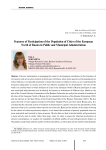
Статья научная
Citizens’ participation in managing the country’s development contributes to the formation of civil society and acts as a key element of democracy. In Russia, where three-quarters of the population are urban residents, it is especially important to study these issues in relation to cities, so as to understand the processes taking place in society and work out effective strategies for its development. The aim of the work is to consider ways in which residents of cities in the European North of Russia participate in state and municipal administration and to identify its features in settlements of different sizes. Based on the data of the Central Election Commission of the Russian Federation we analyze the turnout of residents of 68 cities of the European North of Russia for the presidential election of the Russian Federation (2018) and the election to the State Duma of the Federal Assembly of the Russian Federation (2021). We also assess the level of voter support provided to President Vladimir Putin and the United Russia party. It is revealed that the electoral activity of residents is determined to a greater extent by the peculiarities of the structure of the city’s economy rather than the size of the city. Based on the analysis of the results of voting for the choice of urban improvement objects, it was found that residents of sparsely populated cities are more motivated and involved in these processes. We also find out that territorial public self-government is most actively used in small, rather than large, cities. In order to assess the informal mechanisms of citizens’ participation, we analyze the availability of official profiles of local self-government bodies on VKontakte social media and the number of their subscribers, as well as data on the number of participants in informal urban communities. We have revealed that this method of communication with the authorities is mostly used by residents of small settlements. Scientific significance of the study lies in determining the features of dissemination of various mechanisms of civic participation, depending on the type of city. Practical significance lies in the possibility of using our findings by the authorities in improving the policy of involving citizens in management processes.
Бесплатно
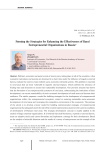
Статья научная
Political, economic and social events of recent years, taking place in all of the countries, when economic institutions and systems are destroyed in a short time under the influence of negative external factors, indicate the need to create resilient socio-economic territorial systems. This problem is essential to rural areas that are most vulnerable to negative external impacts, which confirms the relevance of finding ways and directions to ensure their sustainable development. Our previous research has shown that the formation of an entrepreneurial ecosystem of rural areas, substantiating the institutions of their development, can ensure sustainability of socio-economic development of rural areas and increase their resilience. The article proposes a model for building strategies for the development of entrepreneurial organizations within the entrepreneurial ecosystem, aimed at ensuring sustainable socio-economic development of rural areas and increasing the competitive environment of the ecosystem. The purpose of the article is to develop a factor model for building entrepreneurial strategies of entrepreneurial organizations that adequately meet the role of the rural entrepreneurial ecosystem in the current conditions of development of Russian rural areas. The strategic development concept is usually applied in the analysis of large corporate organizations. It is believed that small businesses, exposed to external factors, must use adaptive tactics and cannot formulate and implement a strategy for their development. Based on the analysis of scientific literature and the results of a survey of entrepreneurs on the example of the Sverdlovsk Oblast of the Russian Federation, we found that rural entrepreneurs seek to determine strategic directions of their development. The article presents approaches to the disclosure of relevant factors that determine the model for choosing a development strategy for rural entrepreneurial organizations. The information base of the study includes research works of Russian and foreign scientists on the topic under consideration, as well as the results of a thematic survey. The scientific novelty of the work lies in the fact that for the first time an attempt has been made to build a factor model for strategic development of rural entrepreneurs within the concept of entrepreneurial ecosystem of rural areas.
Бесплатно
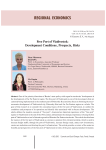
Free port of Vladivostok: development conditions, prospects, risks
Статья научная
One of the priority directions of Russia's state policy with regard to territories' development is the development of the Far Eastern region. The free port of Vladivostok is one of the key projects that are currently being implemented in the southern part of Primorsky Krai and they focus on boosting the socio-economic development of Vladivostok city, Primorsky Krai and the Far Eastern region as a whole. The goal of this research is to consider the conceptual issues of the free port of Vladivostok, to outline the conditions and prospects of its operation and identify risks associated with its future development. The article defines the modern concept of “free port”, characterizes historical experience of the “free port” regime in Vladivostok in the end of the 19th century, substantiates the strategic importance of using the free port of Vladivostok as a tool of intensive growth of Russian Far Eastern territories. The article also discloses the essence of the free port of Vladivostok as a means to promote free entrepreneurship, which is used to increase freight traffic through the port of Vladivostok, increase foreign trade, attract new investments, create new industries and develop the port's infrastructure...
Бесплатно
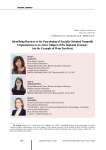
Статья научная
Due to the difficult socio-economic situation of Russia’s regions, it is necessary to involve nongovernmental providers of socially significant services to eliminate government failures. In this regard, socially oriented nonprofit organizations play an important role. As practice shows, despite the recognized importance of such organizations, their potential in the regional economy is not implemented to the fullest extent. Reasons for such a situation are studied in a large number of works, but they do not always take into account territorial specifics, which makes it difficult to identify specific areas of problem solving. Thus, the aim of this study is to identify barriers to and prerequisites for the sustainable development of socially oriented nonprofit organizations as an active subject of the regional economy, effectively implementing its functions in socially significant sectors of the economy on a systematic and long-term basis. To achieve this goal, we analyze the functioning of socially oriented nonprofit organizations (using the example of Perm Territory). The information base includes a set of relevant regulatory documents, data from state and departmental statistics, ratings of RF constituent entities, findings of sociological research commissioned by the Grants Fund of the Governor of Perm Territory in 2020-2022. We systematize the problems that socially oriented nonprofit organizations deal with in their work, according to the impact on the organization, respectively, related to the external and internal environment. On this basis, we outline the conditions necessary to increase the sustainability of the development of socially oriented nonprofit organizations in the region.
Бесплатно
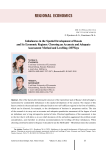
Статья научная
One of the factors determining the structure of the expenditure part of Russia’s federal budget is represented by considerable imbalances in the spatial development of the country. The impact of this factor consists in the annual need to allocate funds to non-self-sufficient regions in the form of subsidies, which can be directed, for example, to the development of business in prosperous entities. The aim of the research is to carry out an accurate and adequate quantitative assessment of the degree of such an imbalance over a long retrospective period of time. Practical significance of the assessment is due to the fact that it will allow us to see which decisions of the authorities aggravated the problem under consideration, and therefore to develop recommendations for levelling off these imbalances. When choosing a method to achieve the goal, we decided to use the Herfindahl - Hirschman index that contains a modification proposed by Professor S.G. Svetunkov, which eliminates its disadvantage consisting in the dependence of the final value on the number of units included in the set under consideration. The use of this indicator has become the main element of the scientific novelty of the study. Having assessed the degree of heterogeneity of the Russian economic space on the basis of information retrieved from the official website of the Federal State Statistics Service, we use regression analysis to derive an equation describing its impact on the structure of the expenditure part of the federal budget. According to the viewpoint that we share, the key tool consists in smoothing out the imbalances within the economic regions that form the country. Their assessment is carried out in a similar way and is also an element of the scientific novelty of the study. Guided by the results obtained, we identify regions where the elimination of vulnerabilities can reduce the heterogeneity of the economic space of the respective economic regions and Russia as a whole. The indicator tested in the study can be used in the future, for example, to assess the degree of uneven distribution of various resources (material, financial, etc.) on the territory of Russia.
Бесплатно
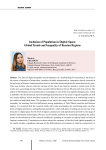
Inclusion of population in digital space: global trends and inequality of Russian regions
Статья научная
The issue of digital inequality and development of a methodology for measuring it has been at the center of attention of researchers, members of public administration, companies directly involved in the provision of Internet communication services, and other interested parties for more than twenty years. This issue became relevant with the increase of the rate of the Internet spread in certain parts of the world, and, accordingly, the lag of other countries behind them in the late 90s and early 21st century. The sphere of information and communication technologies is one of the most rapidly changing ones, which is probably why the theoretical and methodological foundations of the study of digital inequality are still not clearly defined, which actualizes research in this area and the importance of monitoring trends in the world and individual states. The purpose of our work is the usage of the three-level model of digital inequality for assessing first-level differences among population of Third World countries and Russian regions. It is assumed that the research results will create prerequisites for continuing study on other levels of digital asymmetry among Russian population, which will allow revealing not just the fact of its inclusion in digital space but the level of digital competencies and opportunities provide by the usage of modern information technologies. We use a set of scientific methods; for measuring inequality, the author resorts to the calculation of the variation coefficient, grouping of countries or regions based on levels of Internet connectivity. Conclusions are drawn about the existence of the first-level digital inequality in the world, despite a significant decrease of the differentiation of countries by Internet connectivity. It is revealed that Russia, in comparison with other countries, shows a significant increase of the share of Internet users, and there are elements of digital divide within Russian regions even with the decrease of variation coefficients. The scientific novelty of the study is the assessment of the scale and dynamics of the first-level digital inequality among population at the country and regional levels, grouping of countries, and Russian regions by the share of Internet users and the usage of mobile devices to access the network.
Бесплатно
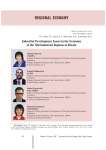
Industrial development issues in the economy of the old industrial regions of Russia
Статья научная
Achieving balanced economic development is a key task for old industrial regions, in which many industrial sectors are concentrated. However, current macroeconomic situation does not promote the development of industrial sectors and new technological modes; moreover, it can lead to a decline in production output, tax proceeds, people's real incomes, consumer demand and other negative trends in socio-economic development. A considerable gap in labor productivity between Russia and developed countries as well as between old industrial regions indicates the existence of major problems in Russian industry. For this reason, the aim of the research is to identify main trends and issues in the industrial sector of old industrial areas in order to work out its further development prospects. Methodological framework of the study includes economic, statistical, and comparative analysis, generalization, and sociological survey. The works of Russian and foreign economists in the field of regional economics, official data of the Federal State Statistics Service, databases of international organizations including the World Bank, the Organization for Economic Cooperation and Development and the U.S...
Бесплатно
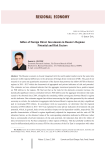
Inflow of foreign direct investments in Russia's regions: potential and risk factors
Статья научная
The Russian economy is closely integrated with the world capital market and at the same time possesses visible regional differences in the dynamics of foreign direct investment (FDI). The goal of our research is to carry out quantitative assessment of the factors that promote the inflow of FDI to Russia's regions in 2011-2017 within the framework of aggregated and private indicators of risk and potential. The estimates we have obtained indicate that the aggregate investment potential has a positive impact on FDI inflows to the regions. We find out that as the risks for the domestic economy increase, the statistically significant inverse correlation between FDI inflows and the aggregate investment risk index ceased to be observed since 2014, alongside the remaining visible convergence between Russia's regions on this indicator. Our estimates suggest that without overcoming the high risks generated by the national economy as a whole, the reduction in aggregate risks between Russia's regions does not play a significant part in increasing FDI inflows. In accordance with our assessment, we determine that the regional dynamics of FDI inflows in 2011-2017 was explained by some private indicators of investment risk and potential, which, in general, had a reverse and direct impact on the dependent variable, respectively. The specific characteristics of Russia's regions significantly adjusted the importance and the ratio of FDI attraction factors, so the obtained values of the corresponding elasticities indicated a difference rather than a commonality of private indicators of risk and potential, the indicators that drive the inflow of direct investment to the Far East compared to other regions of Russia. This fact probably confirms the need for differentiated policies to attract FDI to the economy of the Far East in comparison with other regions. Since our research reflects the relative impact of risk and potential factors on FDI inflows for Russia's regions that exist in the single institutional and economic space, the estimates we have obtained can be supplemented by a more detailed study of the role of Russia's potential and risk compared to other national economies.
Бесплатно
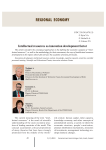
Intellectual resources as innovation development factor
Статья научная
The article considers the conceptual approaches to the defining the economic category of “intellectual resources”, as well as the methodology for their assessment, the ways of intellectual resources development in the regions which did not have the academic divisions previously.
Бесплатно
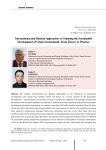
Статья научная
We consider international and Russian approaches to the definition of sustainable development. The report Our Common Future was based on a triune concept of the sustainable development - environmental, social and economic. Gradually the emphasis of sustainable development has shifted from the global problems of continents, separate states and regions to studying the sustainable development of urban environment, as currently more than half of the world’s population lives in cities. On the one hand, cities determine living standards, the improvement of which is a prerequisite for meeting basic needs for employment, housing, health care, education, and rest; on the other hand, they face problems such as lack of financial resources and jobs, increasing homelessness and poverty, widening the gap between the rich and the poor. We present an analysis of the accepted documents of the UN-Habitat on sustainable human settlements development on the Vancouver Declaration on Human Settlements (1976) to the World Cities Report 2022: Envisioning the Future of Cities. We present the European way through the European Charter. The main points and concepts of the sustainable development of big and small cities of Europe are considered from the Aalborg Charter (Denmark, 1994) to the Mannheim Message (Germany, 2020). We analyze northern city ranking, which has been implemented by the Rating agency SGM since 2013. We propose a methodology for assessing the sustainable development of northern cities on eight demographic and labor indicators; conduct a grouping of 115 cities of the Russian North on the types and indicators of the sustainable development, and mark 10 most sustainable cities and 10 - with the worst ranking. The considered theoretical provisions and practical results can be used for comparative studies and planning of territorial development. We suggest the directions for improving the sustainable development of Russia’s northern cities.
Бесплатно
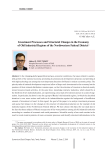
Статья научная
In the changing global geopolitical and geo-economic conditions, the issues related to sustainable growth of the national economy, promoting its pronounced development dynamics and providing it with high technology are among the most important directions for Russia's modern economic policy. The priority tasks of national development require an inflow of large-scale investments in the economy, but the question of their rational distribution remains open, so that the attention of investors is directed mainly toward resource-based activities. At the same time, knowledge-intensive industries, which should be at the forefront of new industrialization, are experiencing a clear lack of investment and are in a state of stagnation. In particular, the above is true for a group of Russia's old industrial regions, in which the described situation is even more serious and leads to de-industrialization against the background of insufficient amount of investment at hand. In this regard, the goal of the paper is to analyze investment processes and assess their impact on the changes in the structure of industrial production on the example of old industrial regions of the Northwestern Federal District. We have chosen this object for our study due to the fact that these subjects of Russia occupy one of the worst positions among all old industrial territories according to a number of economic and social parameters. Scientific novelty of our work consists in the need to reveal modern patterns of socio-economic processes and identify structural deformations in the economy. The findings of our study reflect the current state of investment processes and the nature of structural transformations in the old industrial regions of the Northwestern Federal District, taking place against the background of strengthening resource-based industries. Practical significance of the findings is determined by the fact that they contribute to a better understanding of the current socio-economic situation of the sample under consideration and are useful for further study of the specifics of these territories and the problems they face.
Бесплатно
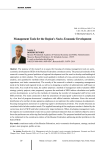
Management tools for the region's socio-economic development
Статья научная
The purpose of the research is to assess the focusing of existing management tools on socio-economic development (SED) of the Russian Federation constituent entity. The practical rationale of the research is caused by general problems of regional development and the need to develop methodological approaches to their solution. The author used qualitative methods of cross-sectoral analysis, document analysis, and quantitative methods (those of principal components, variance calculation, correlations, regressions, and index construction). The novelty of the research is related to comparing management tools at the federal and regional levels, as well as to designing a number of administrative staff based on these tools. As a result of the study, the author proposes a method of management tools evaluation (SED strategy, priority projects, state programs), approves the methods of SED indices calculation and public services development, as well as the methods of rationing the number of managerial staff in line with SED priorities. The main conclusion is that the assessment of stated goals’ achievement is complicated by a low level of program documents’ compliance with official statistics indicators. Since the sectoral distribution of a number of state apparatus employees is not optimal, the author proposes its adjustment, focusing management personnel on achieving region’s development priorities. The results obtained are correlated with the labor market trends. The applied forecasting of the employees number is limited by the correctness level of SED and labor productivity target indicators. When developing management tools, the regions are recommended to take into account statistical indicators that are relatively objective and to focus the performers on achieving final socially significant results. The proposed method has the potential to be replicated in the constituent entities of the Russian Federation addressing similar problems in the field of SED.
Бесплатно
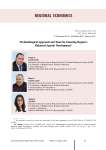
Methodological approach and tools for ensuring region's balanced spatial development
Статья научная
Due to the concentration of labor, financial, and other resources in agglomerations and “denudation” of regions' periphery, a number of significant problems are becoming more acute in the transformation process of spatial economic structure. Such problems threaten the balance of intra- and interregional development. One of them is an important differentiation of Russian regions' municipalities in terms of socio-economic development level. There is a dilemma of choosing the regional spatial policy vector: either to support the growth points' development (agglomerations, special economic zones, territories of advanced socio-economic development), or to reduce socio-economic inequality through additional support for the periphery development. Using the integration of the concepts of the reference frame and sub-regional approach, the research proposes a methodological approach to the balanced spatial development of the region. On the region's territory, the research distinguishes natural sub-regions, which are the elements of the territory's reference economic frame, and artificial sub-regions, which are based on inter-municipal cooperation. The essence of the approach is to establish balance between regulation of natural economic processes in the region (for example, institutionalization and reduction of agglomerations' negative effects) and state support for depressed territories' development (for example, program sub-regions' formation). Its usage in the regional management practice allows forming methodological basis for working out strategic documents for the region's spatial development, economic, organizational, institutional, and social instruments of regional policy. The work presents a set of tools for improving the spatial development balance of the Republic of Bashkortostan, related to the development of natural sub-regions which are already objective growth points in the region, as well as aimed at stimulating the economic self-development of depressed and peripheral territories of the Republic of Bashkortostan.
Бесплатно
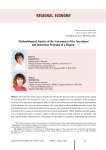
Methodological aspects of the assessment of the investment and innovation potential of a region
Статья научная
The relevance of the study is caused by the fact that the increase of the investment activity, which has remained low over the last few years, is a necessary condition for the transition of the country's economy to an innovative development path. It leads to the preservation of technological backwardness which conserves the structure of the economy with a low share of the knowledge-intensive sector. The interdependence and interconnectedness of investment and innovation processes allows us to review the investment and innovation potential as the basis of their development. While studying scientific papers, it was revealed that issues of content, structure, and the evaluation of this potential are debatable, and they require further comprehension. The purpose of this article is to develop methodological provisions for assessing the investment and innovation potential of the region. In the course of studying the works of domestic and foreign scientists, the authors of the article investigated approaches to determining innovation and investment potentials and methods of their assessment, clarified the content of investment and innovation potential, identified its structural elements, and proposed a methodological approach to its assessment, which allows establishing the relationship between used investment resources and the results of the innovation activity. During the study, we assessed the investment and innovation potential of Russian regions, identified problems of its formation and the usage, as well as trends that make it possible to determine the guidelines for the development of investment and innovation processes. The methodological basis of the research are the methods of system analysis and synthesis, comparison, generalization, grouping and statistical methods. The results of the study may be of practical interest for regional authorities' activities and the management in order to improve the effectiveness of investment and innovation processes. Theoretical generalizations, contained in the article, might be used as materials for the discussion in a scientific discourse.
Бесплатно

